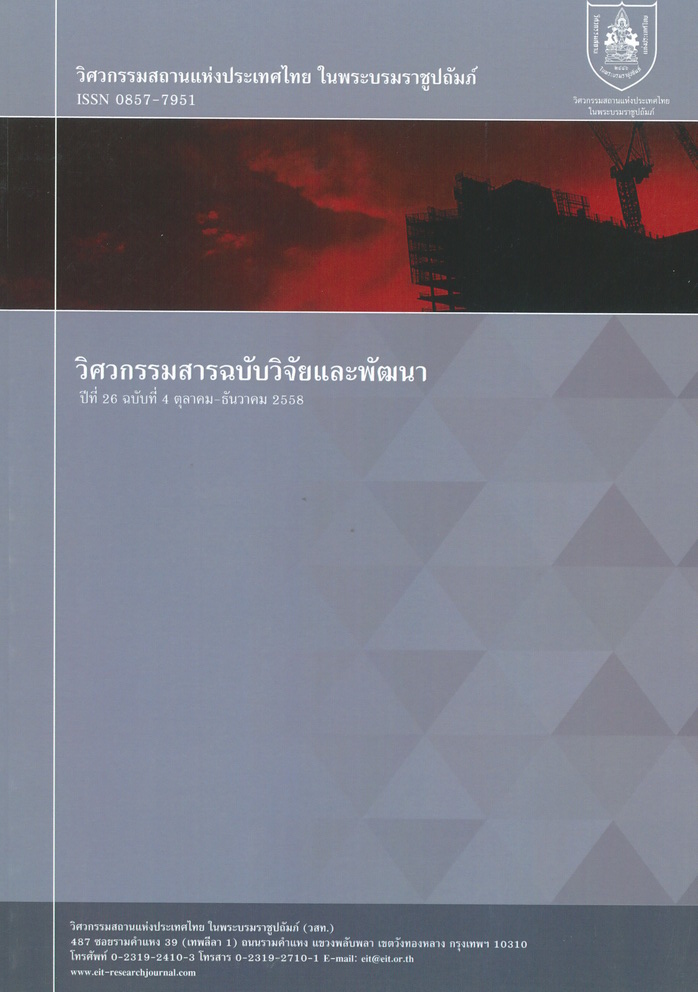A STUDY OF HUMIDITY LEVEL CONSTRAINT FOR SPLIT-TYPE AIR CONDITIONER UNIT
Main Article Content
Abstract
ระบบปรับอากาศมีหน้าที่หลัก คือสร้างความสบายพร้อมกับคุณภาพอากาศที่ดี ซึ่งในขณะเดียวกันก็ต้องมีการคำนึงถึงการใช้พลังงานของระบบปรับอากาศไปพร้อมกันด้วย ความสบายของผู้อยู่อาศัยในอาคารประกอบไปด้วยช่วงอุณหภูมิและความชื้นที่เหมาะสม ภายใต้การหมุนเวียนอากาศที่เพียงพอ อย่างไรก็ตามเครื่องปรับอากาศแบบแยกส่วนโดยทั่วไป ถูกควบคุมการทำงานโดยอุปกรณ์วัดอุณหภูมิแต่เพียงอย่างเดียว การควบคุมความชื้นจึงกลายเป็นหน้าที่โดยทางอ้อมของระบบปรับอากาศ งานวิจัยนี้ได้นำเสนอผลการทดสอบและแนวทางวิเคราะห์ระบบปรับอากาศของห้องสำนักงานตัวอย่าง ผลการทดสอบแสดงให้เห็นถึงผลกระทบของ Cooling load จากจำนวนคน และการระบายอากาศ ส่งผลกระทบทำให้การควบคุมความชื้นมีความแตกต่างกัน ในกรณีนี้ ผลกระทบของการเปิดพัดลมระบายอากาศส่งผลมากกว่าต่อการเพิ่มจำนวนคนในห้องสำนักงาน อย่างมีนัยสำคัญ เนื่องจากการเลือกใช้พัดลมระบายอากาศแบบติดผนังที่หาได้ง่ายตามท้องตลาด แต่มีขนาดใหญ่เกินความต้องการ ของการระบายอากาศ ผลวิเคราะห์ของ Cooling load สำหรับห้องสำนักงาน ที่มีการระบายอากาศ แสดงให้เห็นถึง Cooling load จากพัดลมระบายอากาศ สูงที่สุด และรองลงมา คือ Cooling load จากโครงสร้างภายใน โครงสร้างภายนอก คน การแผ่รังสีของแสงแดดผ่านกระจก และ หลอดไฟ Fluorescent ตามลำดับ เครื่องปรับอากาศมีข้อจำกัดทางด้านการควบคุมอุณหภูมิและความชื้น ซึ่งสามารถวิเคราะห์ได้จาก หลักการถ่ายเทความร้อนของ Sensible heat และ Latent heat ซึ่งจะเห็นได้ว่าจากผลต่างของอุณหภูมิ Supply air และ Room air ที่อยู่ระหว่าง 15-27 deg F จะพบว่า เครื่องปรับอากาศมีความสามารถในการควบคุม Sensible heat ratio ที่แตกต่างกัน ในช่วง 0.55-0.99 สำหรับกรณีศึกษานี้ เครื่องปรับอากาศมี ขนาด 9,000 BTU มีอัตราการไหลของอากาศ 300 CFM ผลต่างของอุณหภูมิ Supply air และ Room air เท่ากับ 20 deg F จะมีค่า Room sensible heat ratio อยู่ที่ 0.73 เมื่อใช้เครื่องปรับอากาศพร้อมกับการเปิดพัดลมระบายอากาศทำให้ RSHR ไปอยู่ที่ 0.50 นั่นคือระบบปรับอากาศจะไม่สามารถควบคุมความชื้นได้ตามที่ต้องการ ดังนั้นการออกแบบระบบปรับอากาศ จะต้องคำนึงถึงระบบระบายอากาศที่เหมาะสม มีการหมุนเวียนอากาศที่เพียงพอ แต่จะต้องไปมากเกินจำเป็น และต้องนำค่าการหมุนเวียนอากาศมาวิเคราะห์ร่วมกับระบบปรับอากาศทุกครั้ง เพื่อทำให้เกิดความมั่นใจว่าระบบปรับอากาศสามารถควบคุมอุณหภูมิและความชื้นไปพร้อมกันได้
The basic purpose of air conditioner is to provide a comfortable and sufficient indoor air quality. By the same time, the energy consumption of air conditioner must be concerned. Human comfort is defined as the appropriate range of temperature and humidity under the sufficient volume flow rate of outdoor air ventilation. However, normal split type air conditioner is controlled by temperature sensor only. The humidity control becomes indirect function of the air conditioning process. This research work proposed the test result and assessment method for the split type air conditioner for an example office room. The test result showed the influences of the number of people and amount of ventilation air flow on the room cooling load. The increment of this cooling load decreases the ability of humidity control. In this study, the amount of ventilation air flow is more significant than the number of people. The wall type ventilation fan is selected because of readily available in the market and economic reason. However, the amount of air flow is normally larger than standard requirement. Heating load calculation in this case shows the highest heating load is from ventilation. The second is from interior structure and the third is from exterior structure. The air conditioner has constraint on temperature and humidity control. This can be evaluated from the sensible heat transfer and latent heat transfer principles. Regarding the difference between the supply air temperature and the room air temperature is from 15 to 27 deg F, the air conditioner has the controllability for the sensible heat ratio from 0.55 to 0.99. In this study, the 9,000 BTU/hr with 300 CFM air flow rate air conditioner and the 20 deg F temperature difference between the supply air temperature and the room air temperature has room sensible heat ratio at 0.73. When the air conditioner works at the same time with ventilation fan, the room sensible heat ratio is at 0.50. That means that the air conditioner cannot be used to control the humidity. Therefore, for the effective design of air conditioner, the amount of airflow for ventilation must be carefully designed and selected. The volume flow rate must be sufficient and comply with standard and regulation but not too high. The volume flow rate must be accounted for cooling load calculation for the selection of the appropriate air conditioner.
Article Details
The published articles are copyright of the Engineering Journal of Research and Development, The Engineering Institute of Thailand Under H.M. The King's Patronage (EIT).

